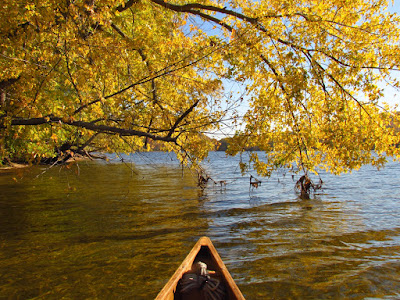It is grey and not particularly cold for December. The day does not measure up to being called, raw. Coming from Minnesota, raw has a harshness that brings with it the slightest onset of pain...cold face, freezing ears, an inner chill that requires time indoors to recover from. It is cold, it is somewhat windy, but it is not raw.
I float the canoe out in 8 or 10 inches of water and then take my seat and paddle off into a stiff headwind knowing that in a half hour or so I will be in the protected channels of Lord's Cove. At the first finger ridge, a mink spots me.
Then, I cross over to the shelter of Goose Island, a large marsh island of phragmites. This is the one thing that phragmites do well other than crowd out animal and other plant species, it blocks the wind.
At the upper end of the island where a broad bay opens up, I let the wind drift me back to the original shore where I can occasionally take shelter behind some rock islands and the distinctive finger ridges that descend from the hills into the river. There are some ducks about, but this is near the end of hunting season and they are extremely wary, flushing well before I can get positive identification on most of them.
I take the first side channel that I can. It cuts back in the direction that I came from and for awhile I wonder if I have made a wrong turn. Then comes the sharp bend to the fight and I recognize the place. I take a second channel that I recall as a dead end. I flush an American bittern from close range...an unexpected surprise and proof that dead ends are worth traveling.
I circle Coutes Hole, the weird round open spot in the marsh that makes no sense and begin my return.
I had spotted a string of twelve lost duck decoys on the way in. I normally collect lost decoys, but these represent a few hundred dollars of lost gear for some hunter who had a bit of brain chill after a day out. It is payback for the good Samaritan that picked my binoculars up off of the ground and set them on my car one day after I set out in my canoe. I retrieve them from the shore and set them on a nearby private boat launch where the owner might be able to find them.
Bodies of water
4 days ago


















































